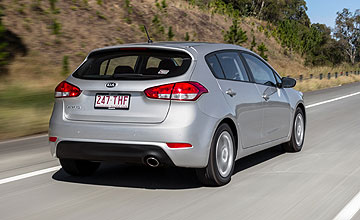BY MIKE COSTELLO | 19th Aug 2013

There are a host of worthy options out there: the Golf, Focus, i30, Mazda3, Cruze and even the new Corolla are all recommendable cars in their own way.
You could throw the new Cerato hatchback into your calculations on driveway appeal alone. It’s an even sharper looking than the (already on-sale) Cerato sedan, making it perhaps the sharpest looker in the segment full-stop.
But let’s not dwell on the style at the expense of substance. Kia’s days of offering cheap and cheerful product are long behind it, but that’s not to say the Cerato doesn’t come full to the brim with standard features.
Fleet-friendly S versions (from $19,990) make do with steel wheels, but they also get cruise control, USB/iPod connectivity with Bluetooth, and front and rear parking sensors.
But move up the range to the $4000 more expensive mid-spec Si, and you’ll get alloys, chrome touches, electric folding mirrors, auto headlights, rear vents, a 4.3-inch touchscreen, reversing camera and push button start.
By the time you’re up to the $27,990 SLi, you get LED daytime running lights, a sunroof, TFT display, electric seat and heated AND vented front seats. That’s a serious bowl of fruit. Only satellite navigation is missing - Kia charges $1000 for it, and only offers it on the SLi, unlike rivals such as Hyundai and Holden (to name but a few) that have it as standard.
Kia also offers a five-year/100,000km warranty and capped price servicing for five-years, making it a good ownership proposition.
The cabin itself has big and friendly switchgear, a high-resolution screen, soft-touch dash padding and door cards (the S gets harder plastic on the doors, though) and an abiding feeling of quality.
The Bluetooth system is laughably easy to use, the USB input is well-situated low on the fascia and the steering wheel audio and cruise controls are simplicity defined.
Rear cargo space of 385 litres is good for the class, and the back seats are cinch to flip forward. There’s also a laudable full-sized spare wheel. Rear leg- and headroom is adequate, though the S variant lacks rear vents, which is unfortunate.
The front seat cushions are wider (322mm) than before and offer good support, the hip points are lower and rear headroom and shoulder room is improved over the old model to the tune of 10mm and 5mm). Not much, granted, but something.
The SLi’s sunroof also eats into headroom - your 194cm tall correspondent found it too tight in the front, my hair and the roof-liner becoming a little too closely acquainted.
Kia makes much of its local suspension tuning, with the company funding a team of engineers in Australia to test and develop specific damper rates (among other things) for our market.
In the case of the Cerato, the team set up the suspension of the 16 x 6.5-inch alloys and 205/55 tyres of the Si, something to which the composed ride quality attests.
Coarse chip freeways showed up the SLi’s noisier (though sexy) 17s and 215/45 combination, and B-road corrugations exhibited sharper jolts through the seats and - in one case - the wheel, with rack rattle rearing its head on a singular occasion.
It’s not Golf or Focus-sharp, but it’s solid. The front suspension is a fully independent MacPherson strut setup, while the torsion beam at the rear saves space and cost yet doesn’t feel particularly prone to pushing the car off line.
Less endearing was the electric steering system, which as with most Kias lacks feel and feedback. The three-way selectable steering adjustment, which adds or removes resistance depending on which mode - comfort, normal or sport - is engaged, is a novelty at best.
It’s arm-achingly heavy in sport mode and too light in comfort. Normal mode is the best compromise, and to buyers we’d say: pick and stick.
Two engines are on offer. The S gets a 110kW/178Nm 1.8-litre engine familiar from the i30. It’s less potent than the old 115kW unit in the previous Cerato, and its peak torque doesn’t arrive until 4700rpm, but it’s a sweet unit that feeds on revs.
The six-speed automatic has a penchant to upshift to save fuel, the corollary of which is the odd hesitancy to kick down. The six-speed manual is a crisp unit with a light clutch, and some may find the inconvenience of a third pedal is countered by the way it wrings more poke from the willing powertrain.
On paper, the 129kW/209Nm 2.0-litre normally aspirated engine in the Si and SLi variants looks to edge warm-hatch territory. But while its outputs come close to matching smaller-capacity turbos in the Cruze SRi (132kW/230Nm) and Nissan Pulsar ST-S (140kW/240Nm), its lack of a blower takes away some signature low-end turbo grunt.
Peak power arrives at 6500rpm and maximum torque at 4700rpm, meaning it - like the 1.8 - needs a rev. But auto versions of the 2.0 are more than one second faster to 100km/h than the 1.8, and feel it.
If you’re going to haul the 1300kg bulk plus loads of four about regularly, best choose the bigger engine: it won’t the world ablaze, but it’s the stronger option.
Engage the paddle shifters (on the SLi, anyway) and it takes on a sportier tone, though it will upshift automatically at redline.
Short, sporting drive legs are not the best time or place for economy runs, so we’ll report on the veracity of Kia’s claimed economy figures of 7.4L/100km on the 2.0 and 6.6L/100km (7.1 for the auto) on the 1.8 after our requisite week-long test soon.
So, to conclude. Kia’s march up the charts continues with the new Cerato hatch.
It’s well-priced, beautifully designed and a sharper tool than ever - if not quite as sharp as a Golf or Focus. Take a look.